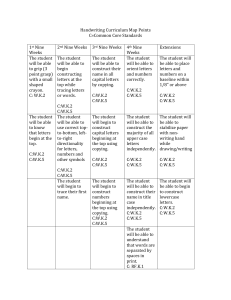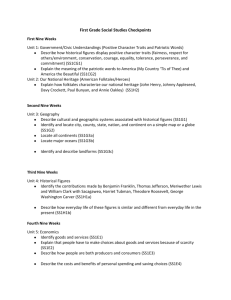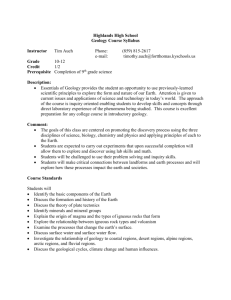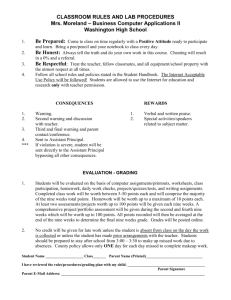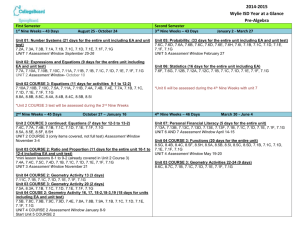High School Physical Geology – Pacing Chart
advertisement
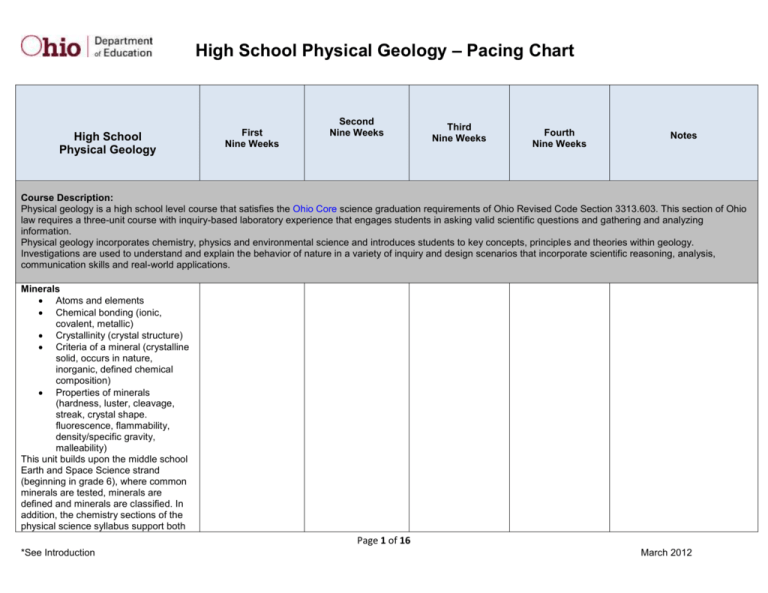
High School Physical Geology – Pacing Chart High School Physical Geology First Nine Weeks Second Nine Weeks Third Nine Weeks Fourth Nine Weeks Notes Course Description: Physical geology is a high school level course that satisfies the Ohio Core science graduation requirements of Ohio Revised Code Section 3313.603. This section of Ohio law requires a three-unit course with inquiry-based laboratory experience that engages students in asking valid scientific questions and gathering and analyzing information. Physical geology incorporates chemistry, physics and environmental science and introduces students to key concepts, principles and theories within geology. Investigations are used to understand and explain the behavior of nature in a variety of inquiry and design scenarios that incorporate scientific reasoning, analysis, communication skills and real-world applications. Minerals Atoms and elements Chemical bonding (ionic, covalent, metallic) Crystallinity (crystal structure) Criteria of a mineral (crystalline solid, occurs in nature, inorganic, defined chemical composition) Properties of minerals (hardness, luster, cleavage, streak, crystal shape. fluorescence, flammability, density/specific gravity, malleability) This unit builds upon the middle school Earth and Space Science strand (beginning in grade 6), where common minerals are tested, minerals are defined and minerals are classified. In addition, the chemistry sections of the physical science syllabus support both Page 1 of 16 *See Introduction March 2012 High School Physical Geology – Pacing Chart High School Physical Geology First Nine Weeks Second Nine Weeks Third Nine Weeks Fourth Nine Weeks Notes mineral properties and crystalline structures (chemical compositions and bonding). The emphasis at the high school level is to relate the chemical and physical components of minerals to the properties of the minerals. This requires extensive mineral testing, investigations, experimentation, observation, use of technology and models/modeling. The focus must be learning the ways to research, test and evaluate minerals, not in memorization of mineral names or types. Properties such as cleavage and hardness must be connected to the chemical structure and bonding of the mineral. In addition, the environment in which minerals form should be part of the classification of the mineral, using mineral data to help interpret the environmental conditions that existed during the formation of the mineral. Igneous, Metamorphic and Sedimentary Rocks Igneous Mafic and felsic rocks and minerals Intrusive (igneous structures: dikes, sills, batholiths, pegmatites) Page 2 of 16 *See Introduction March 2012 High School Physical Geology – Pacing Chart High School Physical Geology First Nine Weeks Second Nine Weeks Third Nine Weeks Fourth Nine Weeks Notes Earth’s interior (inner core, outer core, lower mantle, upper mantle, Mohorovicic discontinuity, crust) Magnetic reversals and Earth’s magnetic field Thermal energy within the Earth Extrusive (volcanic activity, volcanoes: cinder cones, composite, shield) Bowen’s Reaction Series (continuous and discontinuous branches) Metamorphic Pressure, stress, temperature and compressional forces Foliated (regional), non-foliated (contact) Parent rock and degrees of metamorphism Metamorphic zones (where metamorphic rocks are found) Sedimentary The ocean Tides (daily, neap and spring) Currents (deep and shallow, rip and longshore) Thermal energy and water density Waves Ocean features (ridges, Page 3 of 16 *See Introduction March 2012 High School Physical Geology – Pacing Chart High School Physical Geology First Nine Weeks Second Nine Weeks Third Nine Weeks Fourth Nine Weeks Notes trenches, island systems, abyssal zone, shelves, slopes, reefs, island arcs) Passive and active continental margins Division of sedimentary rocks and minerals (chemical, clastic/physical, organic) Depositional environments Streams (channels, streambeds, floodplains, crossbedding, alluvial fans, deltas) Transgressing and regressing sea levels This unit builds upon the middle school Earth and Space Science strand (beginning in grade 6). Sedimentary, igneous and metamorphic rocks are introduced, rocks and minerals are tested and classified, plate tectonics, seismic waves and the structure of Earth are studied, and the geologic record is found (including the evidence of climatic variances through Earth’s history). In the middle school Life Science strand, fossils and depositional environments are included as they relate to the documented history of life in the geologic record. In the physical science syllabus, support for waves, thermal energy, currents, pressure and gravity are presented. Page 4 of 16 *See Introduction March 2012 High School Physical Geology – Pacing Chart High School Physical Geology First Nine Weeks Second Nine Weeks Third Nine Weeks Fourth Nine Weeks Notes At the high school level, geologic, topographic, seismic and aerial maps must be used to locate and recognize igneous, metamorphic and sedimentary structures and features. Technological advances permit the investigation of intrusive structures and the interior of Earth. Connections between the minerals present within each type of rock and the environment formed are important. The processes and environmental conditions that lead to fossil fuel formation (Note: this links to the energy resources section below) must include the fossil fuels found in Ohio, nationally and globally. Bowen’s Reaction Series must be used to develop an understanding of the relationship of cooling temperature, formation of specific igneous minerals and the resulting igneous environment. The focus is on knowing how to use Bowen’s Reaction Series, not to memorize it. Virtual demonstrations and simulations of cooling magma and crystallization of the igneous minerals found on the series can be helpful in conceptualizing the chart. The magnetic properties of Earth must be examined through the study of real data and evidence. The relationship of polar changes, magnetic stripping, grid Page 5 of 16 *See Introduction March 2012 High School Physical Geology – Pacing Chart High School Physical Geology First Nine Weeks Second Nine Weeks Third Nine Weeks Fourth Nine Weeks Notes north, true north and the north pole must be included in the study of Earth’s magnetic properties. While the ocean is included within the sedimentary topic, it can be incorporated into other topics. Features found in the ocean must include all types of environments (igneous, metamorphic or sedimentary). Using models (3-D or virtual) with real-time data to simulate waves, tides, currents, feature formation and changing sea levels to explore and investigate the ocean fully is recommended. Interpreting sections of the geologic record to determine sea level changes and depositional environments, including relative age, is also recommended. Technological advances must be used to illustrate the physical features of the Earth, including the ocean floor. Interpreting geologic history using maps of local cross-sections of bedrock can be related to the geologic history of Ohio, the United States and the Earth. Earth’s History The geologic rock record Page 6 of 16 *See Introduction March 2012 High School Physical Geology – Pacing Chart High School Physical Geology First Nine Weeks Second Nine Weeks Third Nine Weeks Fourth Nine Weeks Notes Relative and absolute age Principles to determine relative age o Original horizontality o Superposition o Cross-cutting relationships Absolute age o Radiometric dating (isotopes, radioactive decay) o Correct uses of radiometric dating Combining relative and absolute age data The geologic time scale o Comprehending geologic time o Climate changes evident through the rock record o Fossil record This unit builds upon the middle school Earth and Space Science strand (beginning in grade 6), sedimentary, igneous and metamorphic rocks are introduced, rocks and minerals are tested and classified, plate tectonics, seismic waves and the structure of Earth are studied, and the geologic record is found (including uniformitarianism, superposition, crosscutting relationships and the evidence of Page 7 of 16 *See Introduction March 2012 High School Physical Geology – Pacing Chart High School Physical Geology First Nine Weeks Second Nine Weeks Third Nine Weeks Fourth Nine Weeks Notes climatic variances through Earth’s history). In the middle school Life Science strand, fossils and depositional environments are included as they relate to the documented history of life in the geologic record. In the physical science syllabus, support for radiometric dating, seismic waves, thermal energy, pressure and gravity are presented. At the high school level, the long-term history of Earth and the analysis of the evidence from the geologic record (including fossil evidence) must be investigated. Using actual sections of the geologic record to interpret, compare and analyze can demonstrate the changes that have occurred in Ohio, in North America and globally. The emphasis for this unit is to explore the geologic record and the immensity of the geologic record. The analysis of data and evidence found in the variety of dating techniques (both absolute and relative), the complexity of the fossil record, and the impact that improving technology has had on the interpretation and continued updating of what is known about the history of Earth must be investigated. Geologic principles are essential in developing this level of knowledge. These principles must be tested and experienced through Page 8 of 16 *See Introduction March 2012 High School Physical Geology – Pacing Chart High School Physical Geology First Nine Weeks Second Nine Weeks Third Nine Weeks Fourth Nine Weeks Notes modeling, virtually, field studies, research and in-depth investigation. Plate Tectonics • Internal Earth o Seismic waves S and P waves Velocities, reflection, refraction of waves o Structure of Earth (Note: specific layers were part of grade 8) Asthenosphere Lithosphere Mohorovicic boundary (Moho) Composition of each of the layers of Earth Gravity, magnetism and isostasy Thermal energy (geothermal gradient and heat flow) • Historical review (Note: this would include a review of continental drift and sea-floor spreading found in grade 8) o Paleomagnetism and magnetic anomalies o Paleoclimatology • Plate motion (Note: introduced in grade 8) Page 9 of 16 *See Introduction March 2012 High School Physical Geology – Pacing Chart High School Physical Geology First Nine Weeks Second Nine Weeks Third Nine Weeks Fourth Nine Weeks Notes o Causes and evidence of plate motion o Measuring plate motion o Characteristics of oceanic and continental plates o Relationship of plate movement and geologic events and features o Mantle plumes This unit builds upon the middle school Earth and Space Science strand (beginning in grade 6). Sedimentary, igneous and metamorphic rocks are introduced, rocks and minerals are tested and classified, plate tectonics (including the history and evidence for plate tectonics), seismic waves and the interior structure of Earth and the geologic record are found. In the middle school Life Science strand, fossils and depositional environments are included. In the physical science syllabus, support for density, convection, conductivity, motion, kinetic energy, radiometric dating, seismic waves, thermal energy, pressure and gravity are presented. At the high school level, Earth’s interior and plate tectonics must be investigated at greater depth using models, simulations, actual seismic data, realtime data, satellite data and remote sensing. Relationships between energy, Page 10 of 16 *See Introduction March 2012 High School Physical Geology – Pacing Chart High School Physical Geology First Nine Weeks Second Nine Weeks Third Nine Weeks Fourth Nine Weeks Notes tectonic activity levels and earthquake or volcano predictions, and calculations to obtain the magnitude, focus and epicenter of an earthquake must be included. Evidence and data analysis is the key in understanding this part of the Earth system. For example, GIS/GPS and/or satellite data provide data and evidence for moving plates and changing landscapes (due to tectonic activity). The causes for plate motion, the evidence of moving plates and the results of plate tectonics must be related to Earth’s past, present and future. The use of evidence to support conclusions and predictions pertaining to plate motion is an important part of this unit. Earth’s Resources • Energy resources o Renewable and nonrenewable energy sources and efficiency o Alternate energy sources and efficiency o Resource availability o Mining and resource extraction • Air o Primary and secondary contaminants o Greenhouse gases Page 11 of 16 *See Introduction March 2012 High School Physical Geology – Pacing Chart High School Physical Geology First Nine Weeks Second Nine Weeks Third Nine Weeks Fourth Nine Weeks Notes • Water o Potable water and water quality o Hypoxia, eutrophication • Soil and sediment o Desertification o Mass wasting and erosion o Sediment contamination This unit builds on the Earth and Space Science content from elementary school, when renewable/nonrenewable energy, soils, the atmosphere and water are introduced, to grades 6-8 when Earth’ spheres, Earth’s resources and energy resources are found, and then to biology and physical science (in particular water, air, chemistry and energy topics) syllabi at the high school level. At the high school science level, renewable and nonrenewable energy resources topics investigate the effectiveness and efficiency for differing types of energy resources at a local, state, national and global level. Feasibility, availability and environmental cost are included in the extraction, storage, use and disposal of both abiotic and biotic resources. Modeling (3-D or virtual), simulations and real-world data must be used to investigate energy resources and exploration. The emphasis must be on Page 12 of 16 *See Introduction March 2012 High School Physical Geology – Pacing Chart High School Physical Geology First Nine Weeks Second Nine Weeks Third Nine Weeks Fourth Nine Weeks Notes current, actual data, contemporary science and technological advances in the field of energy resources. Relating Earth’s resources (energy, air, water, soil) to a global scale and using technology to collect global resource data for comparative classroom study is recommended. In addition, it is important to connect industry and the scientific community to the classroom to increase the depth of understanding. Critical thinking and problem-solving skills are important in evaluating resource use and conservation. Smaller scale investigations, such as a field study to monitor stream quality, construction mud issues, stormwater management, nonpoint sourcecontamination problems (e.g., road-salt runoff, agricultural runoff, parking lot runoff) or thermal water contamination can be useful in developing a deeper understanding of Earth’s resources. Earth Systems must be used to illustrate the interconnectedness of each of Earth’s spheres (the hydrosphere, lithosphere, atmosphere and biosphere) and the relationship between each type of Earth’s resources. Glacial Geology • Glaciers and glaciation o Evidence of past glaciers Page 13 of 16 *See Introduction March 2012 High School Physical Geology – Pacing Chart High School Physical Geology First Nine Weeks Second Nine Weeks Third Nine Weeks Fourth Nine Weeks Notes (including features formed through erosion or deposition) o Glacial deposition and erosion (including features formed through erosion or deposition) o Data from ice cores Historical changes (glacial ages, amounts, locations, particulate matter, correlation to fossil evidence) Evidence of climate changes throughout Earth’s history o Glacial distribution and causes of glaciation o Types of glaciers – continental (ice sheets, ice caps), alpine/valley (piedmont, valley, cirque, ice caps) o Glacial structure, formation and movement This unit builds upon the fourth-grade introduction of Earth’s surface (landforms and features, including glacial geology) and the middle school Earth and Space Science strand, with sedimentary, igneous and metamorphic rocks, sediment and soils, the geologic record and Earth’s history, the cryosphere and the relationship of the analysis of ice cores in understanding Page 14 of 16 *See Introduction March 2012 High School Physical Geology – Pacing Chart High School Physical Geology First Nine Weeks Second Nine Weeks Third Nine Weeks Fourth Nine Weeks Notes changes in climate over thousands of years. Fossils and fossil evidence within the geologic record is found in the Life Science strand, building from second grade through high school biology. Tracing and tracking glacial history and present-day data for Ohio, the United States and globally is an emphasis for this unit. Scientific data found in the analysis of the geologic record, ice cores and surficial geology should be used to provide the evidence for changes that have occurred over the history of Earth and are observable in the present day. New discoveries, mapping projects, research, contemporary science and technological advances must be included in the study of glacial geology. Modeling and simulations (3-D or virtual) can be used to illustrate glacial movement and the resulting features. The focus should be on the geologic processes and the criteria for movement, not on memorizing the names of types of glaciers. Field investigations to map and document evidence of glaciers in the local area (if applicable) or virtual investigations can help demonstrate the resulting glacial features and the impact that ice has had on the surface of Earth Page 15 of 16 *See Introduction March 2012 High School Physical Geology – Pacing Chart High School Physical Geology First Nine Weeks Second Nine Weeks Third Nine Weeks Fourth Nine Weeks Notes throughout history. Real-time data (using remote sensing, satellite, GPS/GIS, aerial photographs/maps) can help support this topic. Page 16 of 16 *See Introduction March 2012


